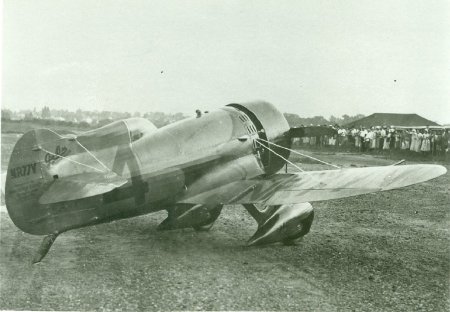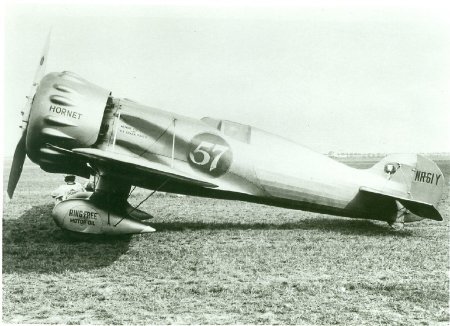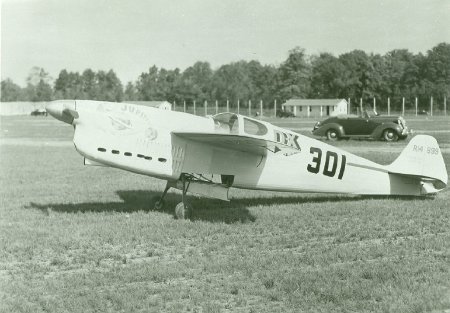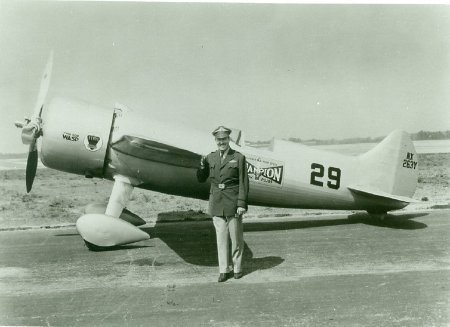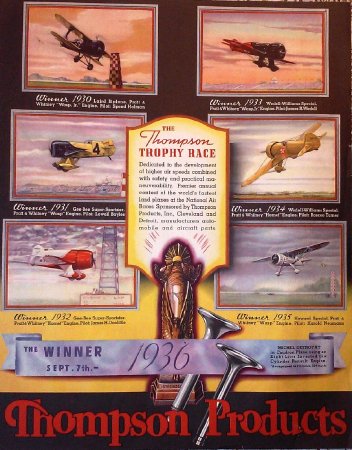Object ID:
2018.1.17
VE Exhibit Label 1:
1930 LAIRD SOLUTION, black and gold colors, powered by a Pratt & Whitney Wasp Jr. engine. Charles W. "Speed" Holman substituted at the last moment for Lee Schoenhair of B.F. Goodrich to win at 201.9 mph after Arthur Page crashed his formidable Curtiss Xf6C6 monoplane early in the race. 100 mile race-Prize purse, $10,000.
1931 GEE BEE SUPERSPORTSTER MODEL Z, black and lemon yellow colors, powered by a Pratt & Whitney Wasp Jr. engine. Lowell R. Bayles purchased stock in the Springfield Air Racing Association and made arrangements to fly this stubby Gee Bee against a field dominated by Jimmy Doolittle in his Laird Super Solution. Doolittle's engine went sour and Bayles had the race to himself, finishing with an average speed of 236.23 mph. 100 mile race-prize purse, $15,000.
1932 GEE BEE SUPERSPORTSTER MODEL R-1, red and white colors, powered by a Pratt & Whitney Wasp engine. Jimmy Doolittle substituted for famed distance flyer Russell Boardman who was injured when he crashed a Gee Bee Sportster a few days before the National Air Races. Doolittle completely dominated the Thompson Trophy Race, finishing with an average speed of 252.68 mph. 100 mile race…prize purse, $10,000.
1933 WEDELL-WILLIAMS 44, black and red, powered by a Pratt & Whitney Wasp Jr. engine. This airplane had been the personal mount of designer Jimmy Wedell since its construction, in quite different configuration, in 1929. Roscoe Turner finished first in this event and had the famous trophy in his arms when a dusty pylon judge ran up to announce his disqualification for cutting a pylon. The race went to Wedell, who had finished second at 248.12 mph. 100 mile race-prize purse $15,000.
1934 WEDELL-WILLIAMS SPECIAL, gold in color, powered by a Pratt & Whitney Hornet engine. Roscoe Turner staged a blistering battle with Doug Davis, in the Wedell-Williams 44, until Davis power-stalled on a pylon turn and dived into the ground. Turner's winnings average speed was 248.12 mph. 100 mile race-prize purse $10,000.
1935 HOWARD MR. MULLIAN, all white in color, powered by a Pratt & Whitney Wasp engine. Roscoe Turner outclassed the field until his engine blew up, forcing him to execute his famous dead-stick landing in front of the grandstands. Harold Neumann went on to win, barreling the big Howard cabin plane through gray, misty skies at an average speed of 220.19 mph. 150 mile race-prize purse, $15,000.
1936 CAUDRON C-460, blue in color, powered by a Renault engine. Michael Detroyat of France, familiar to fans as an acrobatic pilot, brought this slim monoplane to the National Air Races and easily beat the American entries. Roscoe Turner had wiped out his powerful Wedell-Williams monoplane in a spectacular, desert crash. Detroyat finished at an average speed of 264.26 mph, the first pilot to exceed Jimmy Doolittle's record speed in the 1932 race. 150 mile race…prize purse, $20,000.
1937 FOLKERTS SPECIAL 'JUPITER', light cream with red trim, powered by a Menasco C-6S4 engine. Self-styled "hayseed" Rudy Kling nosed out Earl Ortman, going over the finish line. Ortman was pacing his engine, after his ground advised him that he had the race won. 200 mile race-prize purse, $20,550.
1938 TURNER-LAIRD SPECIAL, all silver, powered by a Pratt & Whitney Twin-Wasp Sr. engine. Roscoe Turner really got down to business with this big, powerful ship, incorporating the know-how gained from hundreds of miles of pylon racing. Well-known designers Larry Brown and Matty laird had a hand in building and rebuilding the ship to Turner's specs. Turner averaged 283.419 mph. 300 mile race-prize purse, $41,200.
1939 TURNER-LAIRD SPECIAL, all silver, powered by a Pratt & Whitney Twin-Wasp Sr. engine. Roscoe Turner became the only repeat winner and history's only three-time winner, finishing with an average speed of 282.53 mph over the 300 mile course. Prize purse, $42,000.
1931 GEE BEE SUPERSPORTSTER MODEL Z, black and lemon yellow colors, powered by a Pratt & Whitney Wasp Jr. engine. Lowell R. Bayles purchased stock in the Springfield Air Racing Association and made arrangements to fly this stubby Gee Bee against a field dominated by Jimmy Doolittle in his Laird Super Solution. Doolittle's engine went sour and Bayles had the race to himself, finishing with an average speed of 236.23 mph. 100 mile race-prize purse, $15,000.
1932 GEE BEE SUPERSPORTSTER MODEL R-1, red and white colors, powered by a Pratt & Whitney Wasp engine. Jimmy Doolittle substituted for famed distance flyer Russell Boardman who was injured when he crashed a Gee Bee Sportster a few days before the National Air Races. Doolittle completely dominated the Thompson Trophy Race, finishing with an average speed of 252.68 mph. 100 mile race…prize purse, $10,000.
1933 WEDELL-WILLIAMS 44, black and red, powered by a Pratt & Whitney Wasp Jr. engine. This airplane had been the personal mount of designer Jimmy Wedell since its construction, in quite different configuration, in 1929. Roscoe Turner finished first in this event and had the famous trophy in his arms when a dusty pylon judge ran up to announce his disqualification for cutting a pylon. The race went to Wedell, who had finished second at 248.12 mph. 100 mile race-prize purse $15,000.
1934 WEDELL-WILLIAMS SPECIAL, gold in color, powered by a Pratt & Whitney Hornet engine. Roscoe Turner staged a blistering battle with Doug Davis, in the Wedell-Williams 44, until Davis power-stalled on a pylon turn and dived into the ground. Turner's winnings average speed was 248.12 mph. 100 mile race-prize purse $10,000.
1935 HOWARD MR. MULLIAN, all white in color, powered by a Pratt & Whitney Wasp engine. Roscoe Turner outclassed the field until his engine blew up, forcing him to execute his famous dead-stick landing in front of the grandstands. Harold Neumann went on to win, barreling the big Howard cabin plane through gray, misty skies at an average speed of 220.19 mph. 150 mile race-prize purse, $15,000.
1936 CAUDRON C-460, blue in color, powered by a Renault engine. Michael Detroyat of France, familiar to fans as an acrobatic pilot, brought this slim monoplane to the National Air Races and easily beat the American entries. Roscoe Turner had wiped out his powerful Wedell-Williams monoplane in a spectacular, desert crash. Detroyat finished at an average speed of 264.26 mph, the first pilot to exceed Jimmy Doolittle's record speed in the 1932 race. 150 mile race…prize purse, $20,000.
1937 FOLKERTS SPECIAL 'JUPITER', light cream with red trim, powered by a Menasco C-6S4 engine. Self-styled "hayseed" Rudy Kling nosed out Earl Ortman, going over the finish line. Ortman was pacing his engine, after his ground advised him that he had the race won. 200 mile race-prize purse, $20,550.
1938 TURNER-LAIRD SPECIAL, all silver, powered by a Pratt & Whitney Twin-Wasp Sr. engine. Roscoe Turner really got down to business with this big, powerful ship, incorporating the know-how gained from hundreds of miles of pylon racing. Well-known designers Larry Brown and Matty laird had a hand in building and rebuilding the ship to Turner's specs. Turner averaged 283.419 mph. 300 mile race-prize purse, $41,200.
1939 TURNER-LAIRD SPECIAL, all silver, powered by a Pratt & Whitney Twin-Wasp Sr. engine. Roscoe Turner became the only repeat winner and history's only three-time winner, finishing with an average speed of 282.53 mph over the 300 mile course. Prize purse, $42,000.
Click to Enlarge
